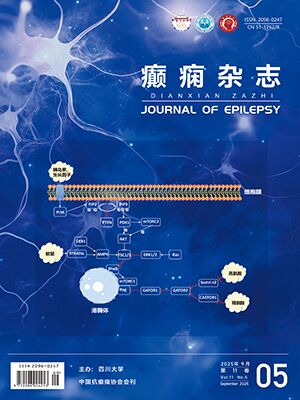| 1. |
Genton P, Thomas P, Kasteleijn-Nolst Trenité DGA, et al. Clinical aspects of juvenile myoclonic epilepsy. Epilepsy & Behavior, 2013, 28(Suppl 1): 8-14.
|
| 2. |
Hofler J, Unterberger I, Dobesberger J, et al. Seizure outcome in 175 patients with juvenile myoclonic epilepsy--a long-term observational study. Epilepsy Res, 2014, 108(10): 1817-1824.
|
| 3. |
Proposal for revised classification of epilepsies and epileptic syndromes. Commission on Classification and Terminology of the International League Against Epilepsy. Epilepsia, 1989, 30(4): 389-399.
|
| 4. |
KasteleijnNolst Trenité DGA, Schmitz B, Janz D, et al. Consensus on diagnosis and management of JME: From founder's observations to current trends. Epilepsy & Behavior, 2013, 28(Suppl 1): 87-90.
|
| 5. |
Camfield CS, Striano P, Camfield PR. Epidemiology of juvenile myoclonic epilepsy. Epilepsy & Behavior, 2013, 28(Suppl 1): 15-17.
|
| 6. |
MartinezJuarez IE, Alonso ME, Medina MT, et al. Juvenile myoclonic epilepsy subsyndromes: family studies and long-term follow-up. Brain, 2006, 129(5): 1269-1280.
|
| 7. |
Baykan B, MartínezJuárez IE, Altindag EA, et al. Lifetime prognosis of juvenile myoclonic epilepsy. Epilepsy & Behavior, 2013, 28(Suppl 1): 18-24.
|
| 8. |
Senf P, Schmitz B, Holtkamp M, et al. Prognosis of juvenile myoclonic epilepsy 45 years after onset: seizure outcome and predictors. Neurology, 2013, 81(24): 2128-2133.
|
| 9. |
Panayiotopoulos CP, Obeid T, Waheed G. Absences in juvenile myoclonic epilepsy: a clinical and video-electroencephalographic study. Ann Neurol, 1989, 25(4): 391-397.
|
| 10. |
Serafini A, Rubboli G, Gigli GL, et al. Neurophysiology of juvenile myoclonic epilepsy. Epilepsy & Behavior, 2013, 28(Suppl 1): 30-39.
|
| 11. |
FernandoDongas MC, Radtke RA, Vanlandingham KE, et al. Characteristics of valproic acid resistant juvenile myoclonic epilepsy. Seizure, 2000, 9(6): 385-388.
|
| 12. |
Crespel A, Gelisse P, Reed RC, et al. Management of juvenile myoclonic epilepsy. Epilepsy & Behavior, 2013, 28(Suppl 1): 81-86.
|
| 13. |
Machado RA, Garcia VF, Astencio AG, et al. Efficacy and tolerability of lamotrigine in juvenile myoclonic epilepsy in adults: a prospective, unblinded randomized controlled trial. Seizure, 2013, 22(10): 846-855.
|
| 14. |
Bodenstein-Sachar H, GandelmanMarton R, BenZeev B, et al. Outcome of lamotrigine treatment in juvenile myoclonic epilepsy. Acta Neurol Scand, 2011, 124(1): 22-27.
|
| 15. |
KasteleijnNolst Trenité DGA, de Weerd A, Beniczky S. Chronodependency and provocative factors in juvenile myoclonic epilepsy. Epilepsy & Behavior, 2013, 28( Suppl 1): 25-29.
|
| 16. |
Krishnan P, Sinha S, Taly AB, et al. Sleep disturbances in juvenile myoclonic epilepsy: a sleep questionnaire-based study. Epilepsy Behav, 2012, 23(3): 305-309.
|
| 17. |
AsadiPooya AA, Hashemzehi Z, Emami M. Predictors of seizure control in patients with juvenile myoclonic epilepsy (JME). Seizure, 2014, 23(10): 889-891.
|




